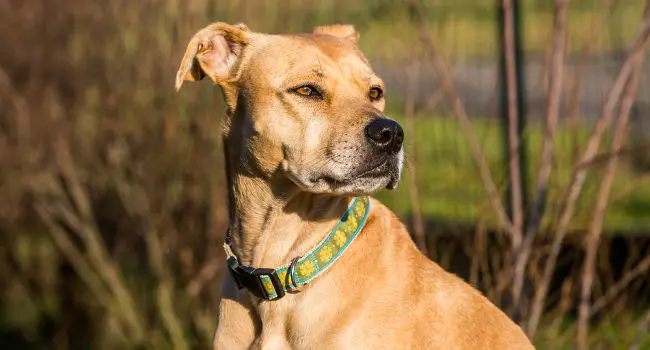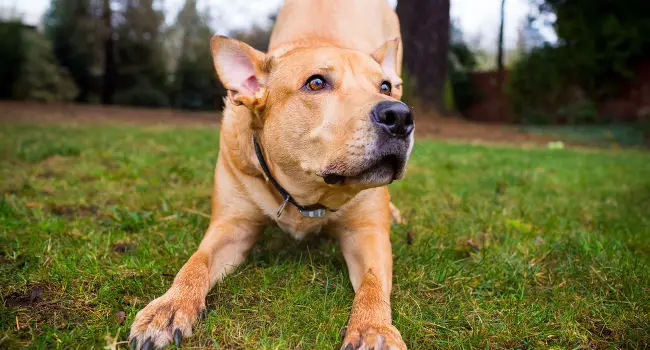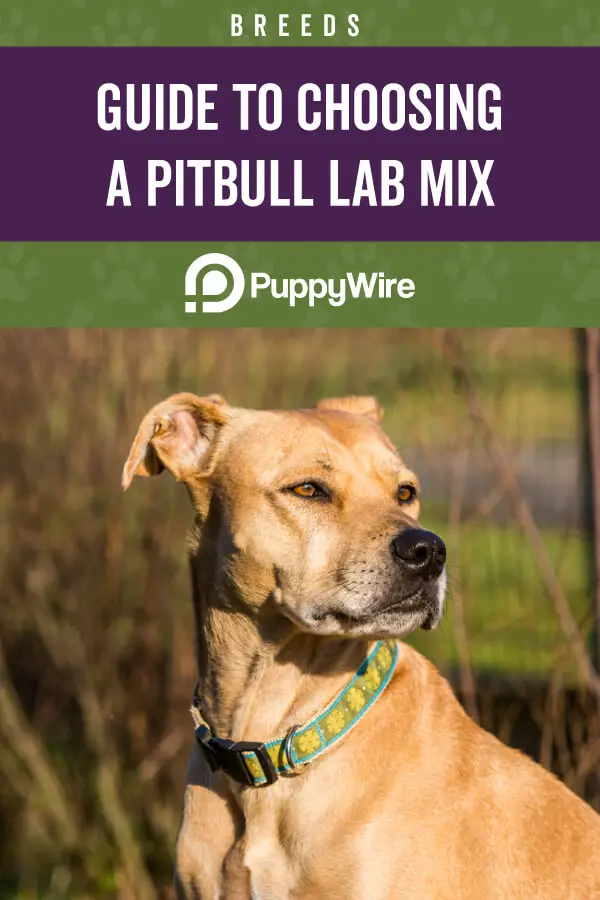Guide to Choosing a Pitbull Lab Mix (Labrabull)

People often breed dogs to get the best traits of both breeds rolled into one dog, and this is why many people look to the Pitbull lab mix to get a smart, loyal, eager to please, and energetic family dog. We’ll tell you everything you need to know about the Labrabull including their temperament, personality, traits, health issues, and why this crossbred dog is so popular.
You’ll also find out how to help your new dog live a long and healthy life and the origins of this fun-loving dog. We’ll also give you tips for owning one of these dogs and honest pros and cons you want to keep in mind when you’re trying to decide if this is the dog for you or not.
History of Pitbull Lab Mixes
As you can imagine, you get this type of dog when you breed the American Pitbull Terrier with the Labrador Retriever. Since there is such a big stigma attached to owning a Pitbull, crossbreeds like this mix are rapidly gaining popularity because people still want the loyal and protective traits of a Pitbull in a more approachable package.
It makes sense that this designer dog is popular because the Labrador Retriever is one of the most popular dogs to own due to their friendly nature. Labrador Retrievers were originally bred to be friendly hunting dogs and Pitbulls were bred to be protective dogs, so you get the best of both worlds with the Labrabull.
While mixing the two breeds doesn’t necessarily guarantee that you’ll get a friendly and non-aggressive puppy, taking a look at the parents and grandparents can give you good indicators of the puppy’s temperament. Additionally, you want to combine this with firm and consistent training to ensure that you get a well-balanced and happy dog.
Temperament of the Pitbull Lab Mixes
One of the first questions people ask when it comes to this mix is the temperament. Ideally, your puppy would have a great balance of both the Lab and Pitbull temperament traits, and this means that you’d get a loyal, even-tempered, and protective dog.
Both breeds are also well known for their eagerness to please, intelligence, and their willingness to learn. Again breeding these two dogs together doesn’t guarantee that you’ll get a puppy with all of these traits, but your puppy has very good odds depending on the parents and how you train and socialize them.
You also want to do your research and determine if this breed is a good fit for you because it will have traits of both of the parents. If you’re not prepared to deal with an intelligent, willful, and energetic dog, this designer dog may not be the best choice for your lifestyle.
Related: Pitbull Dog Food Guide
Socialization Requirements
As we mentioned, it is extremely important that you socialize your crossbred puppy early and often to get them used to different surroundings, people, and other animals. This exposure to different environments and new things will help your dog build their confidence levels, and this can make them less prone to worrying or showing aggression in new situations as they get older.
As soon as you bring your new puppy home, you want to make it a priority to have new people over at least four times per week to expose them to strangers and new situations, and you also want to have a mix of adults and children that give you puppy praise or treats as soon as they come in the door.
You also want to take your dog out to all of the areas that you think you’re going to frequent with them to get them used to the area’s scents and sounds. Additionally, it’s also important that you have supervised playtime with other dogs to get your dog comfortable with being around them, and you can use positive reinforcement each time your puppy has a good interaction.
Appearance
Because you’re breeding two different dogs, it’s not possible to get a 100-percent certain appearance, and these dogs can come in a variety of colors including solid yellow, brown, black, tan, white, and brindle. Along with solid colors, this breed can also have overlapping colors with short and dense fur that doesn’t require a lot of grooming or upkeep.
You should expect to get a dog that weighs between 30 and 80 pounds, and the dog usually has a wider head and Pitbull ears. They have a highly muscled but lean form that stands between 17 and 25 inches at the shoulder, and this gives you a powerful dog who is surprisingly agile due to the retriever’s natural agility and the Pitbull’s strength and compact stature.
Grooming Requirements and Shedding
Labs shed a lot while Pitbulls don’t shed much or at all. This means that your puppy could either shed year-round or barely shed depending on which trait is dominant.
If your puppy sheds a lot, you’ll want to brush them out and groom them regularly to help remove the dead hair and debris. However, if you notice that your puppy isn’t shedding much, you can brush them out once a week or wipe them down with a damp cloth to remove any excess hair or debris that may get tangled in the dog’s coat.
Training Pitbull Lab Mixes
We mentioned earlier that socialization early is key, but consistent training is also extremely important when it comes to these dogs to help ensure that you have a balanced and healthy dog. You want to start training your puppy as soon as you bring them home, and it’s essential that you establish yourself as the dominant force in the home or the dog won’t listen to you as well as they should.
Don’t overwhelm your puppy with several different commands at once, instead, you want to focus on teaching your puppy good manners and one command at a time until you’re sure that they understand it. Also, you want to use positive reinforcement with your puppy because raising your voice or getting angry at them can make them a fearful and aggressive dog that is prone to lashing out.
However, most of these dogs are very eager to please and willing to learn, and this makes them quick learners who pick up new tasks or tricks fast. They’re also very intelligent, and they require a good deal of mental and physical stimulation each day to prevent them from getting bored and engaging in destructive behaviors like chewing or getting into items that they’re not supposed to get into like the garbage.
Health Problems and Longevity

How long your dog lives will depend heavily on their overall health and lifestyle. The good news is that this dog has an average lifespan that ranges between 10 and 13 years and up, and keeping them at a healthy weight is key to having them live for longer periods.
These dogs are less prone to health problems than if you were to own a purebred Labrador Retriever or a purebred Pitbull, but there are still a few things that you want to watch out for. Common health problems with this mixed breed include:
Epilepsy
Most cases of epilepsy in dogs are inherited, so there isn’t a lot you can do to prevent it except to ask and see if the dog’s parents have this condition and how severe it is when they have an episode. Epilepsy can mean that your dog has a few seizures every year, or your dog could have seizures up to a few times a day.
If your dog has two or more seizures a month, your veterinarian may recommend that they go on anticonvulsant medications, but you do have to understand that once you start these medications, your dog will be on them for life because it can increase the chances of having seizures once you remove them. Your vet is the only one who can diagnose epilepsy and prescribe a treatment method for your dog.
Hip Dysplasia
Both Labs and Pitbulls have a higher risk for hip dysplasia, and this puts this particular crossbreed at an even higher risk of developing it. Hip Dysplasia is where your dog’s ball and socket joint in their hip doesn’t glide smoothly together as they walk.
The bones grind together and rub due to a malformation, and this can make it difficult for your dog to stand up, walk, run, go upstairs, or lay down. You can help to prevent hip dysplasia by keeping your dog at a healthy weight and by feeding them joint supplements, but you fix it with surgery if it gets too severe and impacts your dog’s quality of life.
Osteochondrosis
Osteochondrosis occurs mostly in large breeds or breeds that grow very quickly, and it’s a condition where the cartilage in your dog’s joints harden prematurely and make it difficult for your dog to move. They also produce excess cartilage that can crack or weaken as your dog moves around.
If the dog’s parents have this condition, it’s a high risk that your puppy will develop this condition as well, and asking to see the paperwork on them can usually give you a good idea on whether or not your dog is at risk. Surgery is a popular fix for this condition, and there are also some medications that can help prevent the cartilage from weakening or cracking.
Progressive Retinal Atrophy
Another condition that is common with this breed is progressive retinal atrophy, and this condition can cause your dog’s eyesight to deteriorate over time. Eventually, your dog will lose their vision and go blind, and this disease can progress slowly or rapidly.
This condition is also genetic, and it’s common in both Pitbulls and labs as they start to age. Unfortunately, there is no treatment for this condition or ways to slow down the progression of the condition, and dogs who get diagnosed with it will eventually go blind.
Skin Allergies
Both Labs and Pitbulls are prone to developing a variety of skin allergies that cause them to bite, lick, or rub at the itchy area until they’re sore and warm to the touch. The allergies can come from common sources like dust, pollen, cigarette smoke, certain ingredients in their food like wheat or grain, and fleas or parasites.
You can manage your dog’s skin allergies by finding out what they’re allergic to and removing it, and some veterinarians will also offer allergy shots if the allergies are severe enough. Keeping your dog groomed and keeping their skin moisturized is also another way you can help to alleviate the skin allergies your dog has.
Finding a Reputable Breeder
These dogs may be gaining popularity, but they’re not wildly popular yet. This means that you could potentially find one of these mixes for around $100, and the price seems to top out at $500.
However, you want to pay attention to the breeder just like you would if you were going to purchase a purebred puppy because you want to ensure that you get a healthy puppy that doesn’t have any major problems. To start, ask if you can see the puppy’s parents and if the parents have any health issues.
Since this is a crossbred puppy, it most likely won’t come with the traditional papers that you’d see with purebred dogs. Your puppy should come from a clean environment, have a good weight, be free of any parasites or obvious health problems, and the parents should be on site and readily available. Also, your puppy should at least have the first worming medications and shots, and they should be at least 12 weeks old.
You may hear these dogs referred to with several different names including:
- Lab Pit Mix
- Labrabull
- Pit Lab Mix
- Pitador
- Pitbull Lab Mix
Tips for Owners of Pit Lab Mixes
There are a few things that you want to consider before you buy this type of dog because you want to get a dog that fits well into your lifestyle. If you don’t take anything into consideration, you can end up with a dog that is too high maintenance for your lifestyle. These tips include:
- Have room and time to exercise your dog each day because both breeds are higher energy.
- Plan to be around your dog a lot because they don’t do well when you leave them alone for extended periods of time.
- They’re generally safe around children, but they could be too excitable for smaller kids.
- Expect your dog to bark moderately. Pitbulls are usually quiet while labs bark more.
- Consistent training is a must along with early socialization.
- Be sure that you mentally stimulate your dog as well as physically stimulate them to prevent destructive behaviors.
Every puppy is unique, and the Pitbull lab mix is no exception. However, you can turn them into a fun-loving and happy family dog that loves being around their humans and spending time with everyone.
